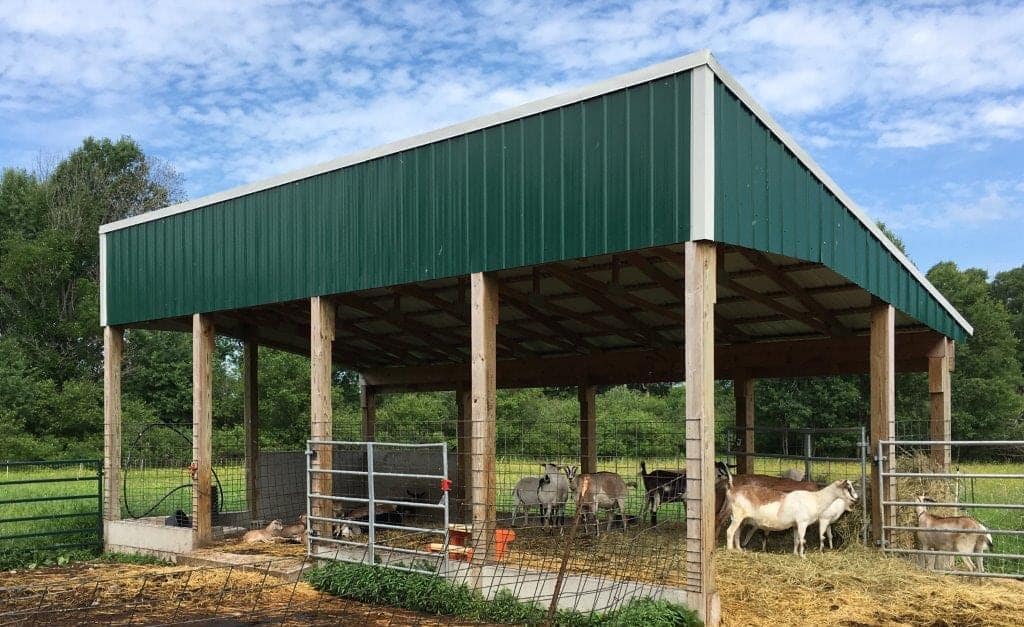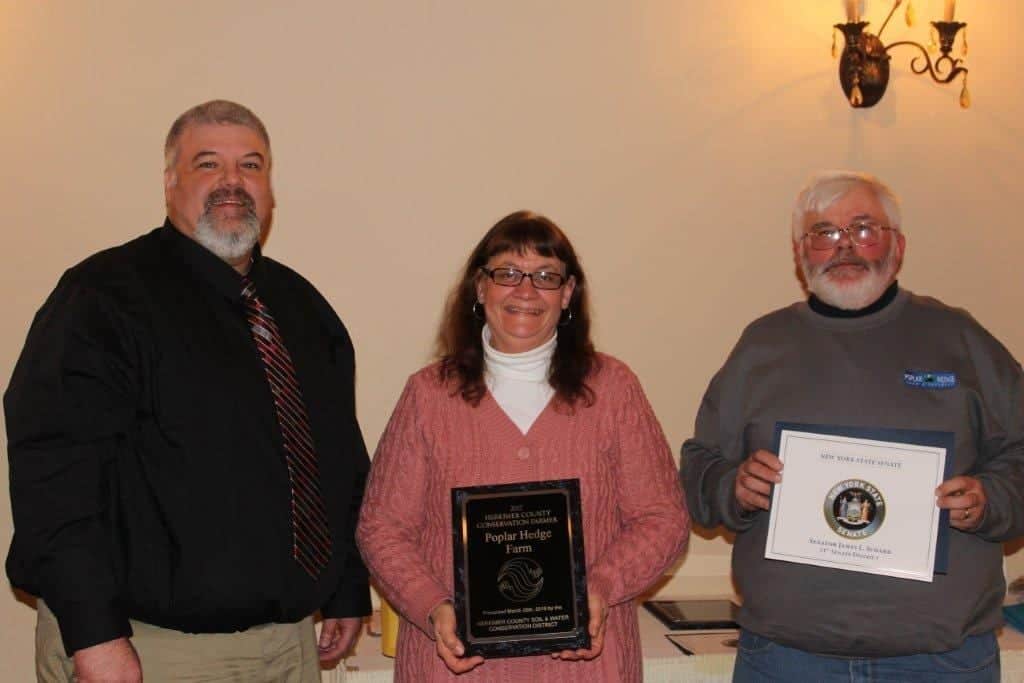Poplar Hedge Farm Taking AEM at Environmental Stewardship
Small, diverse livestock operation committed to implementing environmental stewardship practices.

A covered barnyard was designed and cost shared through AEM implementation allows for a clean area for livestock while reducing runoff into nearby waterways. Courtesy of Judy Littrell / Small Farm Quarterly
Nestled in the countryside near Cooperstown, Poplar Hedge Farm is a producer and direct marketer of goat milk products, poultry, beef and pork. Farm owners Tim and Cindy Powers are implementing New York’s Agricultural Environmental Management (AEM) program, which allows them to incorporate Best Management Practices that help protect water quality and grow their direct marketing farm business.
The Powers purchased their property in 1995 and slowly began to build facilities to house their livestock and eventually their on-farm milk processing plant for their goat milk. They currently maintain a herd of 32 goats, 24 milking age, and raise six replacements each year. The goats are milked in a parlor and the milk is processed on site in their NYS licensed cheese plant. The goat milk is made into chevre, feta, and havarti cheeses, with goat’s milk fudge being a recent addition to Poplar Hedge’s product line. Products are marketed and sold at farmers’ markets, regional events, and on the farm. In addition to goats, the Powers also raise beef cattle, pigs, laying and meat chickens as well as turkeys for the Thanksgiving season.
In the process of building their business, Tim and Cindy have not overlooked their responsibilities of environmental stewardship on the 35 acres they farm; in fact, they have paid extra care to implement environmental practices to preserve their nearby waterways. In 2010, Tim contacted the Herkimer County Soil and Water Conservation District (SWCD), who performed a whole-farm evaluation through the AEM program. AEM is a voluntary, incentive-based program that helps farmers make common sense, cost-effective, and science-based decisions to help meet business objectives while protecting natural resources. It allows farmers to work with AEM professionals to develop comprehensive farm plans using a tiered process. At that time, the Herkimer County SWCD completed an AEM Tier 1 and 2 evaluation of the Powers’ farm, examining future plans of the farm, documenting current land stewardship activities, and assessing and prioritizing areas of concern. Based on the proximity of the farmstead to the Unadilla River and nearby designated wetlands, Tim and Cindy decided to have a Certified Nutrient Management Plan (CNMP) developed for their farm.

A covered manure pad/storage, designed and implemented through AEM and the Herkimer County SWCD allows the Powers to spread manure when field and weather conditions are optimal. The cover reduces nutrient runoff, protecting water quality into laneway and nearby waterways. Courtesy of Judy Littrell / Small Farm Quarterly
The CNMP identified several priorities, including the need to implement proper manure management practices, create a barnyard system that would reduce runoff, and build a milk house waste system. These actions would all help preserve water quality of the stream and wetlands adjacent to the farm. Tim worked with the SWCD to use a portion of AEM funding and the District designed a manure compost facility. The structure reduces nutrient runoff, in comparison to the exposure of an uncovered manure pile, to precipitation events. It also allows Tim to store the manure, avoiding winter spreading, and to apply the manure on fields when conditions are optimum. This benefits the soil to more efficiently use the nutrients in the manure. To compliment the compost facility, a covered barnyard with cement curbs was constructed the following year. It now provides a stable and cleaner surface for the livestock, keeping the animals out of mud and reducing erosion, which helps to improve herd health and milk quality. In addition, the curbs eliminate waste and keep it from running off into waterways.
As part of their whole-farm plan, the Powers have used the services of an animal nutritionist to balance a ration using their homegrown forages. This has helped them to cut costs on purchased feed and maintain milk production. Tim explained that the nutrient-dense composted manure plays a significant role in optimizing their hay crop since they are able to topdress their hay fields for optimum quality and yields.

Gerry Smithson, Herkimer Co. SWCD Manager, with Cindy and Tim Powers, receiving the Herkimer County AEM Farm of the Year award for 2018. Courtesy of Herkimer Co. SWCD.
When asked what drives them to implement BMPs, Tim and Cindy each agree that all farms and landowners need to think about water quality in the future. According to Cindy, “We have to do the right thing for water quality now and in the years to come. It’s our responsibility to consider environmental practices within our farmsteads and encourage all farmers to examine the environmental impacts of their operations.”
Tim credits the Herkimer SWCD and the AEM program as the key to assessing their needs and getting BMPs into place. In 2018, Poplar Hedge Farm was named the Herkimer County AEM Farm of the Year. Tim and Cindy both agree that the AEM program has not only assisted them in protecting natural resources but has also improved the health of their animals and the farm’s productivity. Their future project plans include roof water drainage, a concrete laneway, and the milk house waste system. On the marketing side of the business, they intend to increase the varieties of cheeses they produce.
AEM is a program that is not size or commodity specific and can work on any farmstead in New York to assist farmers in being proactive environmental stewards, benefiting an entire farming operation and New York’s natural resources. AEM is also the environmental stewardship standard, required by producers, to enroll in the New York State Grown and Certified program.
Judy Littrell can be contacted at Judy.littrell@agriculture.ny.gov.
For more information:
The New York State Grown and Certified program launched in 2016 to help meet the growing consumer demand for high quality foods grown or produced to a higher standard within New York State. To be a part of the of New York State Grown and Certified program, participating farmers and processors, must meet food safety standards that pertain to specific commodities, while also meeting the required environmental standard by participating in an AEM assessment which can be completed by a local SWCD, at no cost. The New York State Grown and Certified seal, indicates that the products carrying the seal, have been inspected for safe food handling and environmental stewardship. For more information about the NYS Grown and Certified program, visit https://certified.ny.gov.
To learn more about AEM, contact your local SWCD, or go to https://www.nys-soilandwater.org/aem/index.html. Soil and Water Conservation Districts continue their long record of leading and implementing AEM with farmers at the county level, supported by statewide leadership from the Department of Agriculture and Markets and the NYS Soil and Water Conservation Committee

